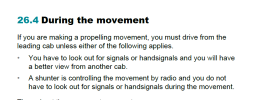Hi All
Looking for some help if possible, can someone actually fully explain what propelling is and it’s speed’s related. Also it’s difference to “driving from other than a leading cab”
I have come across conflicting issues
With speeds and think I may have my wires crossed. I always thought that propelling was pushing without brake continuity, but in tw1 it states that you must drive from the leading cab where possible. Prob is would that not then be hauling and not propelling?
Also understood it to be 5 mph without brake continuity but tw1 suggests 20. ( which I thought was driving from other than…..) but then tw5 states that for this the speed is
“
At a reduced speed which will allow the
movement to be stopped in the distance that
the person controlling the movement can see
to be clear.
Any help is very much appreciated
Thanks
Looking for some help if possible, can someone actually fully explain what propelling is and it’s speed’s related. Also it’s difference to “driving from other than a leading cab”
I have come across conflicting issues
With speeds and think I may have my wires crossed. I always thought that propelling was pushing without brake continuity, but in tw1 it states that you must drive from the leading cab where possible. Prob is would that not then be hauling and not propelling?
Also understood it to be 5 mph without brake continuity but tw1 suggests 20. ( which I thought was driving from other than…..) but then tw5 states that for this the speed is
“
At a reduced speed which will allow the
movement to be stopped in the distance that
the person controlling the movement can see
to be clear.
Any help is very much appreciated
Thanks

